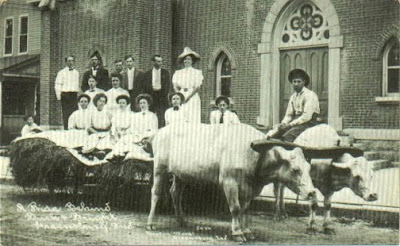When Buck Was A Calf

A caller asked where the saying, “since Buck was a calf” came from. It is sometimes rendered as “when Buck was a calf.” A driver guides a team of harnessed horses principally by the reins in his hands. Oxen, however, are not in harness; they are placed directly in a yoke and they lunge forward to move the attached load.
Commands are verbal -- gee to move left and haw to move right. Gee probably evolved from ree, which was a corruption of right, and haw may have come from the yell for attention: hey!
In any event, the driver would walk alongside the left ox, thus called the near ox, but he could see the ox on the right side, called the off ox. To adjust direction, he would sometimes give a command to one ox only, depending on whether the drift was to the left or the right.
In the 19th century, in an amazing burst of practical uniformity, most oxen were given the same two names. Buck was the name given to the near ox, the one on the left. Bright was the name given to the off ox, the one on the right. A driver could walk up to a different team in confidence, knowing that all teams would respond to the same name and the same commands.
So, “since Buck was a calf” means a significant period of time. Oxen weren’t fully trained and working until they were about four years old. And “as old as Adam’s off ox” means from antiquity.
Credit: Frontier Living by Edwin Tunis
Now available from McFarland & Co.: Word Parts Dictionary, 2nd edition
Listen to Mike’s program in real time every Tuesday morning, 9:00 - 10:00 a.m. EST, by going to wtcmradio.com and clicking on Listen Now. There is now an archive of podcasts. Look under The Ron Jolly Show.
Write to Mike with comments or questions:
wordmallATaol.com
(substitute @ for AT above)
wordmallATaol.com
(substitute @ for AT above)
Visit the Senior Corner at http://seniors.tcnet.org


Comments